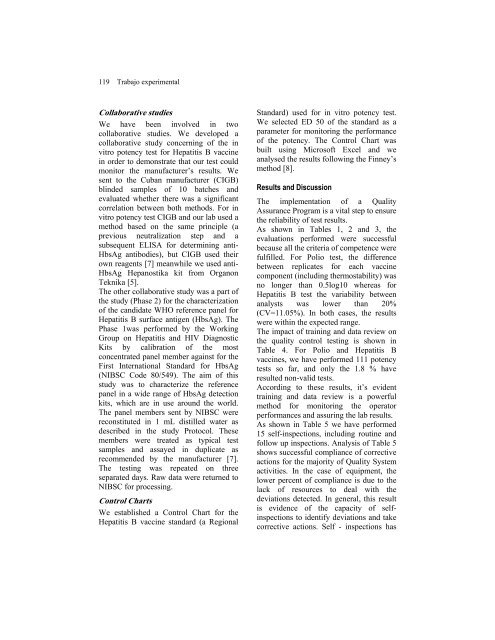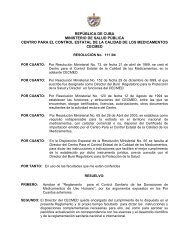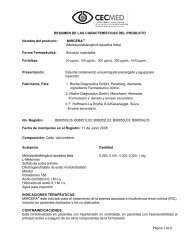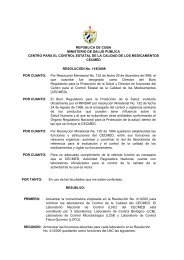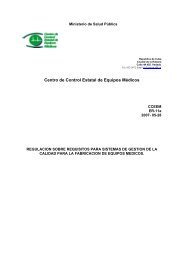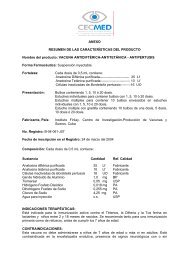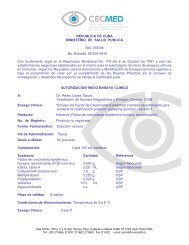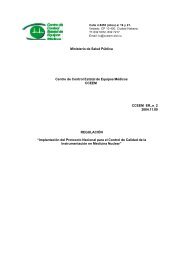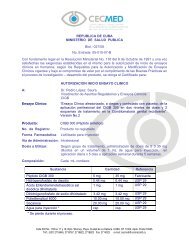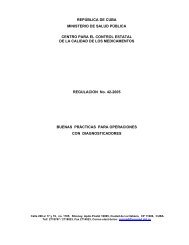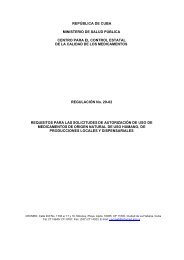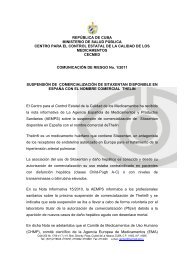AC 2005 Vol-1.pdf - Cecmed - Infomed
AC 2005 Vol-1.pdf - Cecmed - Infomed
AC 2005 Vol-1.pdf - Cecmed - Infomed
Create successful ePaper yourself
Turn your PDF publications into a flip-book with our unique Google optimized e-Paper software.
119 Trabajo experimental<br />
Collaborative studies<br />
We have been involved in two<br />
collaborative studies. We developed a<br />
collaborative study concerning of the in<br />
vitro potency test for Hepatitis B vaccine<br />
in order to demonstrate that our test could<br />
monitor the manufacturer’s results. We<br />
sent to the Cuban manufacturer (CIGB)<br />
blinded samples of 10 batches and<br />
evaluated whether there was a significant<br />
correlation between both methods. For in<br />
vitro potency test CIGB and our lab used a<br />
method based on the same principle (a<br />
previous neutralization step and a<br />
subsequent ELISA for determining anti-<br />
HbsAg antibodies), but CIGB used their<br />
own reagents [7] meanwhile we used anti-<br />
HbsAg Hepanostika kit from Organon<br />
Teknika [5].<br />
The other collaborative study was a part of<br />
the study (Phase 2) for the characterization<br />
of the candidate WHO reference panel for<br />
Hepatitis B surface antigen (HbsAg). The<br />
Phase 1was performed by the Working<br />
Group on Hepatitis and HIV Diagnostic<br />
Kits by calibration of the most<br />
concentrated panel member against for the<br />
First International Standard for HbsAg<br />
(NIBSC Code 80/549). The aim of this<br />
study was to characterize the reference<br />
panel in a wide range of HbsAg detection<br />
kits, which are in use around the world.<br />
The panel members sent by NIBSC were<br />
reconstituted in 1 mL distilled water as<br />
described in the study Protocol. These<br />
members were treated as typical test<br />
samples and assayed in duplicate as<br />
recommended by the manufacturer [7].<br />
The testing was repeated on three<br />
separated days. Raw data were returned to<br />
NIBSC for processing.<br />
Control Charts<br />
We established a Control Chart for the<br />
Hepatitis B vaccine standard (a Regional<br />
Standard) used for in vitro potency test.<br />
We selected ED 50 of the standard as a<br />
parameter for monitoring the performance<br />
of the potency. The Control Chart was<br />
built using Microsoft Excel and we<br />
analysed the results following the Finney’s<br />
method [8].<br />
Results and Discussion<br />
The implementation of a Quality<br />
Assurance Program is a vital step to ensure<br />
the reliability of test results.<br />
As shown in Tables 1, 2 and 3, the<br />
evaluations performed were successful<br />
because all the criteria of competence were<br />
fulfilled. For Polio test, the difference<br />
between replicates for each vaccine<br />
component (including thermostability) was<br />
no longer than 0.5log10 whereas for<br />
Hepatitis B test the variability between<br />
analysts was lower than 20%<br />
(CV=11.05%). In both cases, the results<br />
were within the expected range.<br />
The impact of training and data review on<br />
the quality control testing is shown in<br />
Table 4. For Polio and Hepatitis B<br />
vaccines, we have performed 111 potency<br />
tests so far, and only the 1.8 % have<br />
resulted non-valid tests.<br />
According to these results, it’s evident<br />
training and data review is a powerful<br />
method for monitoring the operator<br />
performances and assuring the lab results.<br />
As shown in Table 5 we have performed<br />
15 self-inspections, including routine and<br />
follow up inspections. Analysis of Table 5<br />
shows successful compliance of corrective<br />
actions for the majority of Quality System<br />
activities. In the case of equipment, the<br />
lower percent of compliance is due to the<br />
lack of resources to deal with the<br />
deviations detected. In general, this result<br />
is evidence of the capacity of selfinspections<br />
to identify deviations and take<br />
corrective actions. Self - inspections has


